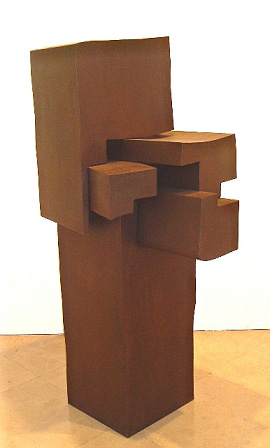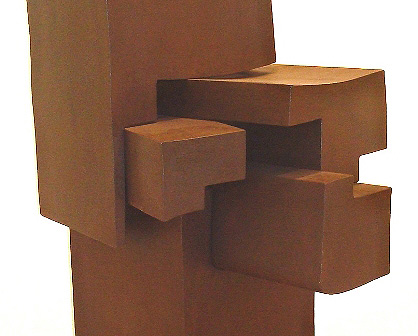The piece of the month of March 2011
CARLOS CIRIZA'S "SPACES UNDER CONSTRUCTION VIII".
José María Muruzábal del Solar
Carlos Ciriza Vega (Estella, 1964) is one of the most valuable and recognized sculptors in Navarre today. programs of study Trained in the tradition of wood and iron craftsmanship in his native Estella, he continued his artistic training at the School of Arts and Crafts in Pamplona. From that moment on his training has been self-taught, traveling and studying the work of the greatest masters of sculpture. His first individual exhibition was in 1986, in the conference room of Art Conde Rodezno of the CAMP. From that moment on his work has been present in numerous prestigious galleries and institutions internationally, in Spain, USA, France, Philippines, Portugal, Japan, etc. In the fall of 2011, an anthological exhibition collects the last 25 years of his production under the degree scroll "The passage of time through movement, 1986 - 2011". The sample, composed of 120 works of painting and sculpture, can be visited at the conference room of the Fallen, with sponsorship of the City Council of Pamplona.
Ciriza began his training, as we indicated, working with wood and other materials that could complement it. Over time, this artist ended up opting for steel, especially corten steel, which is the material he works with nowadays. This material also fits magnificently with the idea of monumentality that we mentioned earlier. And the material itself adapts in a singular way to the artist's public sculpture, giving the work patinas, reflections, lights and shadows, etc.
Carlos Ciriza is a man of great restlessness and great constancy in the work, an artist who never stops looking for new ways of expression, looking for new forms in which to transmit his inner anxieties and ideas. A sculptor who likes patinas, contrasts, to carefully study the location of his works, to take advantage of the qualities ... A man of his own code, Ciriza's sculptural work is inscribed within the expressionist abstraction. Abstract because figuration, although not completely lost in many of his works, always plays a secondary role. This abstraction always seeks to awaken in those who observe the work sensations, ideas, suggestions?
Carlos Ciriza's sculpture is always imbued with a clear vocation for monumentality. I believe this is one of the essential features of his work. We are before an artist who creates grandiose forms, sculptures that seem to demand spaces and locations. It is not just a mere question of size but rather of the very concept of his works. Even when he works in small format, the work itself is made with that monumental concept we have mentioned. For this very reason, the internship totality of her works fit magnificently in the landscape, outdoors, surrounded by grass, trees and environment, executed in large format. And this is the origin of the vocation, appetite and interest that this artist has always shown in approaching and working with public sculpture.
In his production, geometric shapes, spaces, games of shapes and volumes, contrasts work in final. His sculptural work flees from statism and always seeks to break the statism with movements and slides, using curves and spaces. The voids always play an important role in this sculptural production, especially those internal voids inherited from the great masters of contemporary sculpture, such as Oteiza and Chillida. In addition to this, they usually capture the surrounding space, with undulating movements, with forms that come out of the main body and that initiate the apprehension of new spaces on the outside.
This is an artist who has always had a vocation for public works. The sculpture of public vision that the artist has installed in the streets, parks and roads of Navarra is abundant. This artist has always shown interest in taking art to the street, putting it in contact with the citizens, so that they find it in their urban walks or when they go to their jobs, so that there ends up being an interrelation between the sculptural work and anonymous citizens, of all class and condition. Carlos Ciriza's monumentality always has its own interpretation that emanates from the artist, a deep and coherent sense. But this does not eliminate the possibility that each spectator may contribute his own idea or interpretation.
The artist is currently engaged in different projects that will surely allow him to locate new works in Navarra in the near future. Several towns in Navarra are also working on future projects. All this, together with the youth of this restless artist, makes us think that we are in front of a sculptor with great projection of future and that, although at the moment he is opening new ways of work in the United States, he is called to locate, in a near future, an important issue of works in our Community.

"Spaces under construction VIII". Carlos Ciriza
Corten steel
2006
Measurements: 1600 x x cm
The sculpture that we bring to this "Piece of the month", from the Chair de Patrimonio y Arte Navarro, appears in the anthological exhibition of the conference room of Conde Rodezno in Pamplona. The degree scroll "Spaces under construction" is significant with respect to what the piece conveys, forms and spaces in movement, under construction. This work is part of a series of sculptural works of similar format, let's say of a medium size within the production of this author. In these works Ciriza investigates spaces with movement, forms that dissociate as if they were part of a puzzle, forms that seek other ways of structuring themselves and that play with the interior spaces and hollows.
The present work must be inscribed within the expressionist abstraction that we indicated above, in which he plays with geometric shapes, with spaces, with shapes and volumes, with contrasts. This work is perfectly related to the production of the great masters of Basque Sculpture of the 20th century, with the pieces of Jorge de Oteiza or Eduardo Chillida. It is elaborated with corten steel subjected to oxidation process until reaching those patinas and reflections so characteristic. It is also a work of monumental vocation, which seeks to project itself, which needs its own space.
The Catalog that has been published to accompany the anthological sample includes contributions from various specialists in the subject, both Navarrese and from other places. I would like to end these lines with a statement that is included in the Catalog and which seems to me to be extremely accurate. The accredited Mexican critic Rodolfo Casparius indicates there, referring to Carlos Ciriza's sculptures, "I do not try to describe them, because I cannot do it; they are expressions in iron of a soul. You have to see them ... you have to feel them ... you have to admire them and think about what Carlos wants to tell us in each of his sculptures". It can be a magnificent lesson to face the sculpture that we present in these lines and to visit the anthological exhibition of Carlos Ciriza. Beyond criticism, historians or descriptions, these works must be admired, thought about and felt. I sincerely believe that without these premises we will hardly be able to approach Contemporary Sculpture.

Detail of the work
